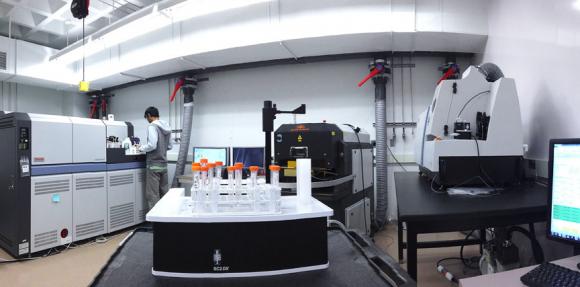PROVIDENCE, R.I. [Brown University] — Researchers from Brown University and around the region have a set of powerful new tools to help with highly sensitive chemical detective work.
The tools are two plasma mass spectrometers. One is capable of detecting elements in all kinds of materials at the level of less than one part per billion. The other one can determine the isotope ratio of an element — a marker that helps scientists determine the origin and age of a material — with incredible precision. Now, Alberto Saal, professor of geological sciences and principle investigator of that lab, is making it available to researchers from other universities, government agencies, and companies around the region.
“These are the most powerful spectrometers in the state of Rhode Island and among the few advanced mass spectrometers in the country,” Saal said. “We want to make the lab available to researchers in many disciplines from around the state and beyond.”
The powerful machines have a variety of applications across disciplines ranging from geochemistry, climate and environmental studies, archaeology, biochemistry, planetary sciences, ecology, material sciences, and forensic sciences.
The spectrometers’ high sensitivity gives them advantages over older mass spectrometers. For example, researchers only need a very small amount of the material they want to analyze. “In the old days, we had to prepare fairly large amounts of a sample,” said Soumen Mallick, a research scientist who works in the lab. “Now we only need to prepare a few pieces — a couple of tiny grains.”
That sensitivity also means very small error margins. Older machines routinely had errors margins as high as one per thousand. These spectrometers are capable of accurate measurements at one per million — a vanishingly small error rate.
That level of precision is especially important when measuring isotope ratios, which provide researchers with valuable information about the origin and ages of all kinds of materials from meteorites to archeological artifacts to environmental samples. Isotope ratios act a bit like a natural barcode, recording a distinct signature of where the material came from and what may have happened to it along the way.
In Saal’s research, isotopes provide precise information about the interior of the Earth and Moon. Lava erupting to the surface bears the isotopic signature of the mantle reservoirs that produced it and the time period of its formation. Tracking those isotopes helps Saal and his colleagues reconstruct the formation and movement of lava and their reservoirs, ultimately leading to a better understanding of evolution of terrestrial bodies.
But that is by no means the only use of stable and radiogenic isotope analysis.
Environmental scientists could use the device to identify contaminants and trace their sources. Climate scientists could analyze lake sediments and track climate variation over time. Anthropologists and archaeologists use isotopes to reconstruct the flow of metals, ceramics, and other goods along ancient trade routes as well as track the migration of people in the past. Material scientists use the mass spectrometer technique to identify the impurities in a material.
The Brown lab also has a state-of-the-art metal-free clean room to prepare samples for mass spectrometry analysis. The facility helps reduce outside contamination in samples, which, in combination with the high-sensitivity instrument, enables researchers to examine smaller chemical variations in the samples.
The lab also houses an advanced laser ablation device that enables researchers to perform in situ analysis in most materials at a high spatial resolution, down to a few microns. The technique is useful in determining the composition of a particular mineral within a rock, for example.
“The new lab vastly expands the cutting-edge research capabilities at Brown,” Saal said, “and we hope researchers from all over the region will come and take advantage of it.”
Funding to purchase the new spectrometer came from the National Science Foundation and Brown University.

